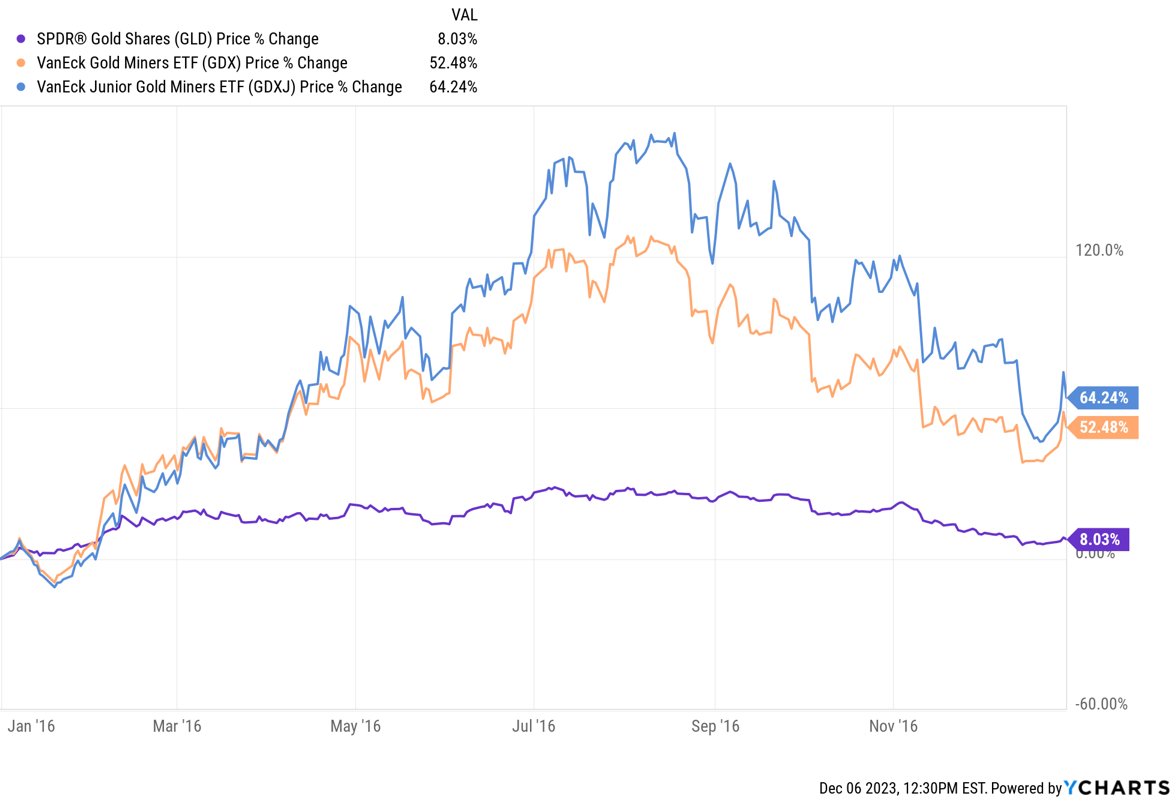How to Find the Best Gold Stocks
Buying gold stocks is an easier way for investors to gain exposure to the precious metal, but not all are created equal. Here's how you find the best ones.


Believe it or not, if you'd like to invest in gold, your best play might not be gold itself, but something a little more indirect: Gold stocks.
While owning the physical metal is the purest way of investing in gold, it's also the most cumbersome. You have to find somewhere to buy it (though, hey, you can get it at Costco), get it shipped, determine a secure way to actually store the gold, insure it, and then, when you're ready to sell, find a buyer and figure out how to deliver it.
If you're averse to butt pains, you've got a much easier method at your disposal: gold stocks. Because they're publicly traded companies, they don't give you perfect exposure to the price of gold – indeed, they often trade much more aggressively (in both directions) than the metal. But they're much more affordable on a nominal dollar basis, and you can buy them with a click of a button in your brokerage account.
So read on as we talk about what a gold stock is, why you'd want one, and what to consider when seeking out the best gold stocks.

What are gold stocks?
The term "gold stocks" simply refers to companies involved in the gold mining process. And, generally speaking, there are three types of gold stocks:
Miners: Gold miners are companies that are actually involved in extracting gold out of the earth. Miners typically develop a mining facility, mine the gold – which involves extracting ore and then processing it into gold – then sell the metal to buyers, who will use the gold to make anything from coins and bars to jewelry to electronic components.
Junior miners: Despite the term "miners," junior gold miners don't actually mine for anything. They're exploration companies that search out potential gold deposits and determine feasibility of the mines. Gold miners then buy these assets from the juniors – and from time to time, they'll buy the junior firms outright.
Royalty companies: Royalty companies never get anywhere close to physical gold. Instead, these firms provide financing to miners, who in turn agree to pay the royalty company either a percentage of revenues or gold production.
In all cases, the price of gold has a lot of sway on how these stocks perform. High gold prices mean higher selling prices for miners, higher deposit sales prices for junior miners, and higher royalties for royalty companies.
In fact, the metal's price impacts gold stocks' financial situations so much that miners' share prices tend to trade much more drastically than the metal itself. And given that juniors are typically a much more high-risk, high-reward proposition than actual mining companies (which also tend to be larger), juniors typically trade in an even more exaggerated fashion.
One of the clearest illustrations of this: 2016, when gold prices rose for a half a year before pulling back.

This dynamic exists for better or worse. Consider this Goldman Sachs observation about gold miners from late 2023:
"Across the gold space, the gold miners in our coverage have underperformed the commodity by 14% year-to-date, driven by idiosyncratic factors (i.e. capex increases, M&A, operational execution challenges)."

How to find the best gold stocks
While gold prices are arguably the most important factor behind the price movement in gold stocks, it's not the only one. Asset quality, company quality, management ability, and more, set one gold stock apart from the next.
If you're looking for the best gold stocks, here are a few things to consider:
All-in sustaining costs: All-in sustaining costs (or just all-in costs) are the total costs of producing an ounce of gold. These include materials, labor, taxes, royalties and more. In general, the lower the all-in costs, the better. Think of it as protection against lower gold prices. For example, let's say Gold Miner A has all-in costs of $1,200 per ounce, and Gold Miner B has all-in costs of $1,400 per ounce. Even if gold dropped from current prices around $2,100 per ounce to $1,300 per ounce, Gold Miner A's profit margin will be much smaller, but it will still be profitable – whereas Gold Miner B will actually be producing gold at a loss.
Exposure to other metals besides gold: Exposure to other metals isn't inherently a good or bad thing – it's merely a consideration as you're selecting an individual gold stock to buy. If you want a company that can best help you leverage the price of gold, you probably want a pure-play gold miner. However, if you want a diversified company that can perform well if gold prices rise, but won't necessarily crash if gold prices do, you might want to consider a miner that deals in multiple metals – say silver, platinum, iron, nickel, etc.
Individual stocks vs ETFs: It can be exceedingly difficult for beginner investors to tell one gold stock from another. Also, even though gold stocks hinge greatly on gold prices, it's possible to pick a poor individual producer. So, rather than single out one or two mining stocks, you might consider owning dozens through an exchange-traded fund. Two of the most popular gold ETFs are the VanEck Gold Miners Equity ETF (GDX), which holds large, established gold miners, and the VanEck Junior Gold Miners ETF (GDXJ), which, as the name suggests, owns juniors.
Related content
Get Kiplinger Today newsletter — free
Profit and prosper with the best of Kiplinger's advice on investing, taxes, retirement, personal finance and much more. Delivered daily. Enter your email in the box and click Sign Me Up.
Kyle Woodley is the Editor-in-Chief of WealthUp, a site dedicated to improving the personal finances and financial literacy of people of all ages. He also writes the weekly The Weekend Tea newsletter, which covers both news and analysis about spending, saving, investing, the economy and more.
Kyle was previously the Senior Investing Editor for Kiplinger.com, and the Managing Editor for InvestorPlace.com before that. His work has appeared in several outlets, including Yahoo! Finance, MSN Money, Barchart, The Globe & Mail and the Nasdaq. He also has appeared as a guest on Fox Business Network and Money Radio, among other shows and podcasts, and he has been quoted in several outlets, including MarketWatch, Vice and Univision. He is a proud graduate of The Ohio State University, where he earned a BA in journalism.
You can check out his thoughts on the markets (and more) at @KyleWoodley.
-
 10 Major AI Companies You Should Know
10 Major AI Companies You Should KnowThese 10 AI companies are at the forefront of machine learning. Find out how they’re driving innovation and jostling to be the biggest players in the game.
By Tom Taulli Published
-
 How Baby Boomers and Gen Xers Are Redefining Retirement Living
How Baby Boomers and Gen Xers Are Redefining Retirement LivingBoth generations need to embrace change and leverage real estate as a dynamic asset in their retirement planning. Here's how financial advisers can help, too.
By David Conti, CPRC Published
-
 CPI Report Puts the Kibosh on Rate Cuts: What the Experts Are Saying About Inflation
CPI Report Puts the Kibosh on Rate Cuts: What the Experts Are Saying About InflationCPI Consumer price inflation reared its ugly head to start the year, dashing hopes for the Fed to lower borrowing costs anytime soon.
By Dan Burrows Published
-
 Fed Leaves Rates Unchanged: What the Experts Are Saying
Fed Leaves Rates Unchanged: What the Experts Are SayingFederal Reserve As widely expected, the Federal Open Market Committee took a 'wait-and-see' approach toward borrowing costs.
By Dan Burrows Published
-
 CPI Report Keeps the Fed on Track: What the Experts Are Saying About Inflation
CPI Report Keeps the Fed on Track: What the Experts Are Saying About InflationCPI Disinflation in key areas of consumer prices should help the Federal Reserve stick to its policy path of gradual cuts to interest rates.
By Dan Burrows Published
-
 Blowout December Jobs Report Puts Rate Cuts on Ice: What the Experts Are Saying
Blowout December Jobs Report Puts Rate Cuts on Ice: What the Experts Are SayingJobs Report The strongest surge in hiring since March keeps the Fed on hold for now.
By Dan Burrows Published
-
 Fed Sees Fewer Rate Cuts in 2025: What the Experts Are Saying
Fed Sees Fewer Rate Cuts in 2025: What the Experts Are SayingFederal Reserve The Federal Reserve cut interest rates as expected, but the future path of borrowing costs became more opaque.
By Dan Burrows Published
-
 CPI Report Casts Doubt on Rate Cuts in 2025: What the Experts Are Saying About Inflation
CPI Report Casts Doubt on Rate Cuts in 2025: What the Experts Are Saying About InflationCPI November Consumer Price Index data sealed the deal for a December rate cut, but the outlook for next year is less certain.
By Dan Burrows Published
-
 Rebound in Jobs Growth Keeps Fed on Track: What the Experts Are Saying
Rebound in Jobs Growth Keeps Fed on Track: What the Experts Are SayingJobs Report No nasty surprises in the November payrolls data leaves a quarter-point cut in play.
By Dan Burrows Published
-
 October CPI Report Hits the Mark: What the Experts Are Saying About Inflation
October CPI Report Hits the Mark: What the Experts Are Saying About InflationCPI While the current pace of rising prices appears to have leveled off, the expected path of rate cuts has become less certain.
By Dan Burrows Published
